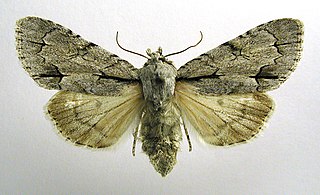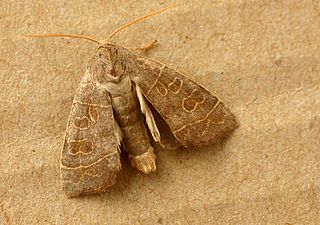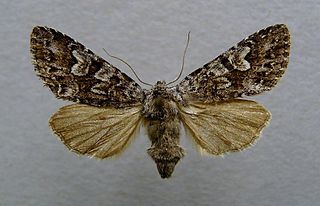
The dot moth is a moth of the family Noctuidae. The species was first described by Carl Linnaeus in 1761. It is a very distinctive species with very dark brown, almost black, forewings marked with a large white stigma from which the species gets its common name. The hindwings are grey with a dark band at the termen. The wingspan is 38–50 mm. It flies at night in July and August and is attracted to light, sugar and flowers.

The Hebrew character is a moth in the family Noctuidae. The species was first described by Carl Linnaeus in his 1758 10th edition of Systema Naturae. It is found throughout Europe.

The poplar grey is a moth of the family Noctuidae. It is found throughout Europe.

The miller is a moth of the family Noctuidae. It is found throughout Europe apart from the far south-east. The range extends from the South of Spain, Central Italy and Bulgaria to Scotland and Central Scandinavia, crossing the Arctic circle in Finland and Norway. Outside Europe it is only known in North Africa. In the Eastern Palearctic and the Nearctic realm it is replaced by Acronicta vulpina, formerly known as Acronicta leporina subspecies vulpina.

The dark dagger is a moth of the family Noctuidae. The species was first described by Michael Denis and Ignaz Schiffermüller in 1775. It is distributed throughout Europe, Turkey, the Near East, the European part of Russia, southern Siberia, the Ural, the Russian Far East, the Korean Peninsula, China and Japan (Hokkaido).

The grey dagger is a moth of the family Noctuidae.

Acronicta auricoma, the scarce dagger, is a moth of the family Noctuidae. It is distributed through most of the Palearctic.

Acronicta menyanthidis, the light knot grass, is a moth of the family Noctuidae. It is distributed through northern, central and eastern Europe, east to Siberia and the Russian Far East.

Acronicta strigosa, the marsh dagger, is a moth of the family Noctuidae. It is distributed through most of Europe, east to the Caucasus, northern China, Korea and Japan.

Ipimorpha subtusa, the olive, is a moth of the family Noctuidae. It is found in the Palearctic realm.

Colocasia coryli is a moth of the family Noctuidae. It is found in Europe and Asia. In the north of its range, the distribution area includes northern Scandinavia, while in the south the moth is limited to montane areas of western and northern Spain, Sicily, Greece and Asia minor. To the east, the range extends across the Palearctic to Lake Baikal. In the Alps it is found at elevations up to 1600 m.

Helotropha leucostigma, the crescent, formerly Celaena leucostigma is a moth of the family Noctuidae. It is found in the Palearctic realm.

Xestia baja, the dotted clay, is a species of moth of the family Noctuidae. It is found in Europe, Turkey, northern Iran, Transcaucasia, the Caucasus, central Asia, Siberia, Mongolia, Tibet, China, Korea and Japan.

The Essex y is a moth of the family Noctuidae. It is found from Italy to Greece, southeastern Europe, southwestern Russia, the southern parts of the Ural, Africa, Canary Islands, Arabia, southwestern Asia, Ceylon, from India to Nepal, southeastern China and Japan.

Agrotis ripae, the sand dart, is a moth of the family Noctuidae. The species was first described by Jacob Hübner in 1823. It is found in western Europe and North Africa and extends east across the Palearctic to steppe areas in Russia, Mongolia and Siberia.

Papestra biren, the glaucous shears, is a moth of the family Noctuidae. The species was first described by Johann August Ephraim Goeze in 1781. It is found in most of Europe, but not in the southern parts of the Iberian Peninsula, Italy and Greece. Outside of Europe it is found in Kashmir and through the Palearctic to Siberia, Central Asia, Amur, Kamchatka, the Russian Far East and Japan. It was introduced in Newfoundland in 1935 and has since then extended its range ever more southward within North America partly overlapping with Papestra quadrata(Smith, 1891). It rises to 2200 m above sea level in the Alps.

Agrotis trux, the crescent dart, is a moth of the family Noctuidae. The species was first described by Jacob Hübner in 1824. It has a circum-Mediterranean distribution and is found along the coasts of France, Ireland, England, southern Europe, Algeria, Syria, Iraq, Iran, southern Russia and the Arabian Peninsula. In Africa, it is found as far south as South Africa.

Coenophila subrosea, the rosy marsh moth, is a moth of the family Noctuidae. The species was first described by James Francis Stephens in 1829. It is found from southern Great Britain, Italy and France, through central Europe north to Scandinavia, east to Russia, from Siberia to the Amur region, Ussuri and Sakhalin, south to northern China, east to Korea and northern Japan.

The silky wainscot is a moth of the family Noctuidae. It is found in most of Europe including Russia.

Apamea oblonga, the crescent striped, is a moth of the family Noctuidae. The species was first described by Adrian Hardy Haworth in 1809. It is found in northern and central Europe, east to southern Russia, Asia Minor, Armenia, Turkestan, Turkey, Iran, southern Siberia, northern Pakistan, Mongolia, China, Sakhalin and Japan




















